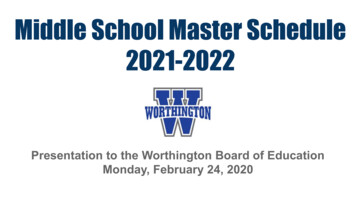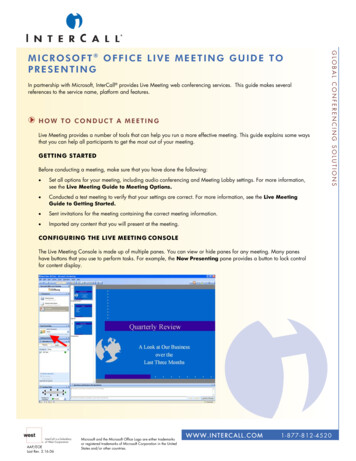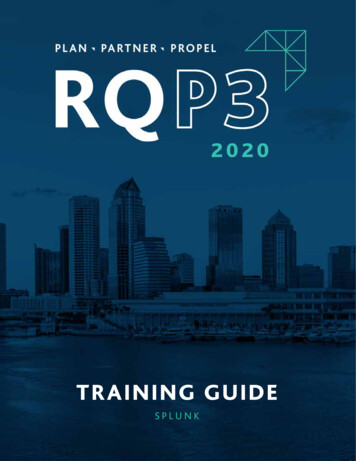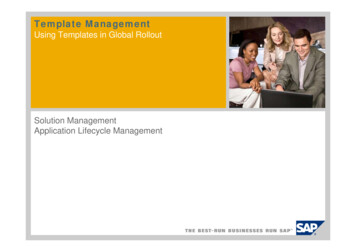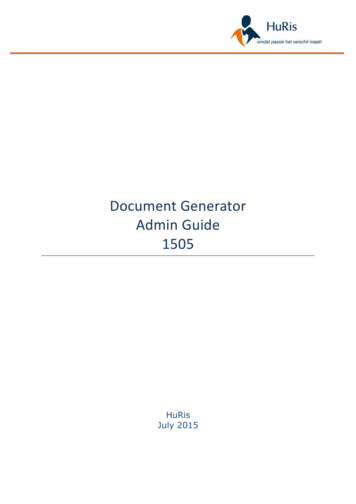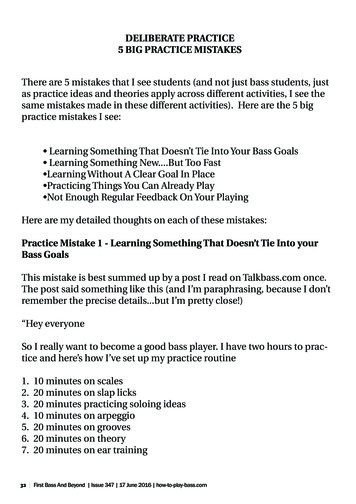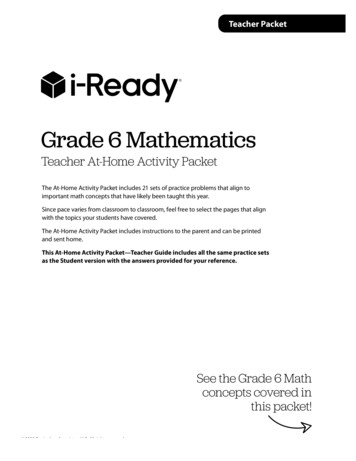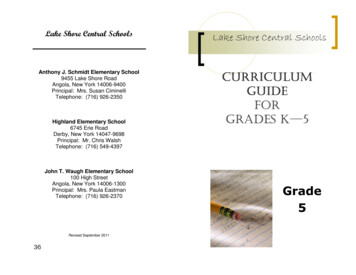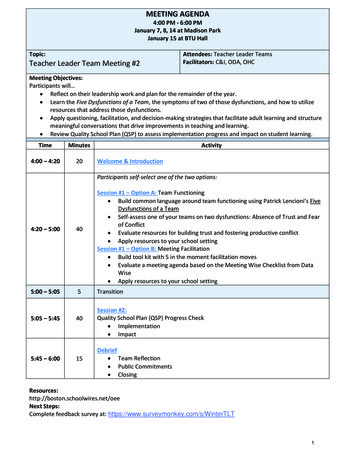
Transcription
MEETING AGENDA4:00 PM - 6:00 PMJanuary 7, 8, 14 at Madison ParkJanuary 15 at BTU HallTopic:Teacher Leader Team Meeting #2Attendees: Teacher Leader TeamsFacilitators: C&I, ODA, OHCMeeting Objectives:Participants will Reflect on their leadership work and plan for the remainder of the year. Learn the Five Dysfunctions of a Team, the symptoms of two of those dysfunctions, and how to utilizeresources that address those dysfunctions. Apply questioning, facilitation, and decision-making strategies that facilitate adult learning and structuremeaningful conversations that drive improvements in teaching and learning. Review Quality School Plan (QSP) to assess implementation progress and impact on student learning.TimeMinutes4:00 – 4:2020ActivityWelcome & IntroductionParticipants self-select one of the two options:4:20 – 5:00405:00 – 5:0555:05 – 5:45405:45 – 6:0015Session #1 – Option A: Team Functioning Build common language around team functioning using Patrick Lencioni’s FiveDysfunctions of a Team Self-assess one of your teams on two dysfunctions: Absence of Trust and Fearof Conflict Evaluate resources for building trust and fostering productive conflict Apply resources to your school settingSession #1 – Option B: Meeting Facilitation Build tool kit with 5 in the moment facilitation moves Evaluate a meeting agenda based on the Meeting Wise Checklist from DataWise Apply resources to your school settingTransitionSession #2:Quality School Plan (QSP) Progress Check Implementation ImpactDebrief Team Reflection Public Commitments Next Steps:Complete feedback survey at: https://www.surveymonkey.com/s/WinterTLT1
Table of ContentsAGENDATABLE OF CONTENTSSESSION A RESOURCESFIVE DYSFUNCTIONS OF A TEAM SUMMARYTEAM ASSESSMENTRESOURCE EVALUATION TEMPLATEBUILDING TRUST RESOURCESFOSTERING PRODUCTIVE CONFLICT RESOURCESSESSION B RESOURCESFACILITATION MOVES TABLEMEETING WISE CHECKLISTMEETING WISE BLANK TEMPLATESAMPLE ILT AGENDASESSION QSP RESOURCESPUBLIC COMMITMENTPG. 1PG. 2PG. 3PG. 4PG. 5PG. 7PG. 13PG. 23PG. 25PG. 26PG. 27PG. 29PG. 332
3
The Five Dysfunctions of a TeamBy Patrick LencioniPG. 192 - 194Instructions: Use the scale below to indicate how each statement applies to your team. It is importantto evaluate the statements honestly and without over-thinking your answers.3 Usually2 Sometimes1 Rarely1. Team members are passionate and unguarded in their discussion of issues.4. Team members quickly and genuinely apologize to one another when they say or dosomething inappropriate or possibly damaging to the team.6. Team members openly admit their weaknesses and mistakes.7. Team meetings are compelling, and not boring.10. During team meetings, the most important – and difficult – issues are put on the table to beresolved.12. Team members know about one another’s personal lives and are comfortable discussingthem.*These questions have been selected from a longer team assessment which is why they are numbered in this way. For the fullteam assessment please reference the book, Five Dysfunctions of a Team.ScoringCombine your scores for the preceding statement as indicated below.Dysfunction 1: Absence of TrustStatement 4:Dysfunction 2: Fear of ConflictStatement 1:Statement 6:Statement 7:Statement 12:Statement 10:Total:Total:A score of 8 or 9 is a probable indication that the dysfunction is not a problem for your team.A score of 6 or 7 indicates that the dysfunction could be a problem.A score of 3 to 5 is probably an indication that the dysfunction needs to be addressed.Regardless of your scores, it is important to keep in mind that every team needs constant work, because without it,even the best ones deviate toward dysfunction.4
Instructions: Please use this template as you go through each resource to capture your group’s thinking as you evaluate each resource and considerpossible applications.ResourcePossible UsesPossible ObstaclesPossible ModificationsNext Steps Which resource, if any, do you see yourself using in your school? How? If you don’t see yourself using any of these resources, whatcould be some potential next steps for your team(s)?5
6
Building nterwww.nsrfharmony.orgNorth, South, East and West:Compass PointsAn Exercise in Understanding Preferences in Group WorkDeveloped in the field by educators affiliated with NSRFSimilar to the Myers-Briggs Personality Inventory, this exercise uses a set of preferences which relate not toindividual but to group behaviors, helping us to understand how preferences affect our group work.1. The room is set up with four signs on each wall — North, South, East and West.2. Participants are invited to go to the “direction” of their choice. No one is only one “direction,” buteveryone can choose one as their pre-dominant one.3. Each “direction” answers the five questions on a sheet of newsprint. When complete, they report backto the whole group.4. Processing can include: Note the distribution among the “directions”: what might it mean? What is the best combination for a group to have? Does it matter? How can you avoid being driven crazy by another “direction”? How might you use this exercise with others? Students?NorthActing – “Let’s do it;”Likes to act, try things,plunge in.WestPaying attention to detail—likes to know the who,what, when, where and whybefore acting.N WEEastSpeculating – likes to lookat the big picture and thepossibilities before acting.SSouthCaring – likes to knowthat everyone’s feelingshave been taken intoconsideration and that theirvoices have been heardbefore acting.Protocols are most powerful and effective when used within an ongoing professional learning community such as a Critical Friends Group and facilitatedby a skilled coach. To learn more about professional learning communities and seminars for new or experienced coaches, please visit the National SchoolReform Faculty website at www.nsrfharmony.org.7
Building TrustNorth, South, East and WestDecide which of the four “directions” most closely describes your personal style. Then spend 15 minutesanswering the following questions as a group.1. What are the strengths of your style? (4 adjectives)2. What are the limitations of your style? (4 adjectives)3. What style do you find most difficult to work with and why?4. What do people from the other “directions” or styles need to know about you so you can work togethereffectively?5. What do you value about the other three styles?Protocols are most powerful and effective when used within an ongoing professional learning community such as a Critical Friends Group and facilitatedby a skilled coach. To learn more about professional learning communities and seminars for new or experienced coaches, please visit the National SchoolReform Faculty website at www.nsrfharmony.org.8
Fears and Hopes ProtocolDeveloped in the field by educators.PurposeOne purpose is simply to help people learn some things about each other. The deeper purpose,however, is to establish a norm of ownership by the group of every individual’s expectations andconcerns: to get these into the open, and to begin addressing them together.DetailsTime for this protocol can vary from 5 to 25 minutes, depending on the size of the group and the rangeof their concerns. If the group is particularly large, the facilitator asks tables groups to work togetherand then report out. The only supplies needed are individual writing materials, newsprint and markers.Steps1. Introduction. The facilitator asks participants to write down briefly for themselves their greatest fear forthis meeting/ workshop/ retreat/ class: “If this were the worst meeting (class) you have ever attended,what will happen or not happen? (Adapt it to make it age appropriate)” Then they write their greatesthope: “If this is the best meeting (class) you have ever attended, what will be its outcomes (what wouldI learn)?”2. Pair-Share. If time permits, the facilitator asks participants to share their hopes and fears with a partner.3. Listing. Participants call out fears and hopes as the facilitators lists them on separate pieces of newsprint.4. Debriefing. The facilitator prompts, “Did you notice anything surprising or otherwise interesting whiledoing this activity? What was the impact on you or others of expressing negative thoughts? Would youuse this activity in your school (at home)? In your classroom? Why? Why not?”Facilitation TipsThe facilitator should list all fears and hopes exactly as expressed, without editing, comment, orjudgment. One should not be afraid of the worst fears. A meeting always goes better once these areexpressed. The facilitator can also participate by listing his or her own fears and hopes. After the listof fears and hopes are complete, the group should be encouraged to ponder them. If some thingsseem to need modification, the facilitator should say so in the interest of transparency, and make themodifications. If some of the hopes seem to require a common effort to realize, or if some of the fearsrequire a special effort to avoid, the facilitator should say what he or she thinks these are, and solicitideas for generating such efforts. It is easy to move from here into norm-setting: “In order to reach ourhoped-for-outcomes while making sure we deal with our fears, what norms will we need?”Protocols are most powerful and effective when used within an ongoing professional learning community and facilitated by a skilled facilitator. To learn moreabout professional learning communities and seminars for facilitation, please visit the School Reform Initiative website at www.schoolreforminitiative.org9
VariationOne variation that cuts down on time is to use picture or picture postcards that have fairly ambiguousmeaning, and to ask participants to introduce themselves and tell how the images they have picked(randomly) express their hopes and fears for the meeting. In this variation, the facilitator listens carefullyand makes notes while participants speak, so as to able to capture expressed hopes and fears for thegroup’s reflection.Protocols are most powerful and effective when used within an ongoing professional learning community and facilitated by a skilled facilitator. To learn moreabout professional learning communities and seminars for facilitation, please visit the School Reform Initiative website at www.schoolreforminitiative.org10
Possible Protocol: Have each team member fill out their storyboard individuallyEach team member verbally shares their storyboard. This could be the entire storyboard or select parts. To close, each team member should reflect on one thing that they have learned about a colleagueStoryboard:The Self I Bring to WorkBuilding Trust Scene 1Sharing Personal HistoriesPart 1: Origin of My First NamePart 2: City of My BirthPart 3: GenderPart 4: Race/Ethnicity/National OriginPart 5: One Way I Am Like My FatherPart 6: One Way I Am Like My MotherPage 111
Storyboard:The Self I Bring to WorkBuilding TrustScene 2Sharing Personal HistoriesPart 7: One Thing that I am Very Proud OfPart 8: My Favorite Things to Do in My SpareTimePart 9: Something Someone Did for Me Recently that Made Me Feel GoodPart 10: The Source of My Values ComesFrom.Part 11: I Know I’m Successful When I.Part 12: One Thing I Value About My WorkPage 212
Fostering Productive ConflictWe Have to Talk:A Step-By-Step Checklist forDifficult ConversationsThink of a conversation you’ve been putting off. Got it? Great.Then let’s go.There are dozens of books on the topic of difficult, crucial,challenging, important (you get the idea) conversations (I listseveral at the end of this article). Those times when you knowyou should talk to someone, but you don’t. Maybe you’ve triedand it went badly. Or maybe you fear that talking will onlymake the situation worse. Still, there’s a feeling of being stuck,and you’d like to free up that stuck energy for more usefulpurposes.What you have here is a brief synopsis of best practicestrategies: a checklist of action items to think about before goinginto the conversation; some useful concepts to practice duringthe conversation; and some tips and suggestions to help yourenergy stay focused and flowing, including possibleconversation openings.You’ll notice one key theme throughout: you have more powerthan you think.Working on Yourself: How To Prepare for theConversationBefore going into the conversation, ask yourself some questions:1. What is your purpose for having the conversation? Whatdo you hope to accomplish? What would be an idealoutcome?76 Park StreetPortsmouth, NH 03801-5031phone & fax: er.com13
Fostering Productive ConflictWatch for hidden purposes. You may think you have honorable goals, like educatingan employee or increasing connection with your teen, only to notice that your languageis excessively critical or condescending. You think you want to support, but you endup punishing. Some purposes are more useful than others. Work on yourself so thatyou enter the conversation with a supportive purpose.2. What assumptions are you making about this person’s intentions? You may feelintimidated, belittled, ignored, disrespected, or marginalized, but be cautious aboutassuming that this was the speaker's intention. Impact does not necessarily equalintent.3. What “buttons” of yours are being pushed? Are you more emotional than thesituation warrants? Take a look at your “backstory,” as they say in the movies. Whatpersonal history is being triggered? You may still have the conversation, but you’ll gointo it knowing that some of the heightened emotional state has to do with you.4. How is your attitude toward the conversation influencing your perception of it? Ifyou think this is going to be horribly difficult, it probably will be. If you truly believethat whatever happens, some good will come of it, that will likely be the case. Try toadjust your attitude for maximum effectiveness.5. Who is the opponent? What might he be thinking about this situation? Is he awareof the problem? If so, how do you think he perceives it? What are his needs andfears? What solution do you think he would suggest? Begin to reframe the opponentas partner.6. What are your needs and fears? Are there any common concerns? Could there be?7. How have you contributed to the problem? How has the other person?4 Steps to a Successful OutcomeThe majority of the work in any conflict conversation is work you do on yourself. Nomatter how well the conversation begins, you’ll need to stay in charge of yourself, yourpurpose and your emotional energy. Breathe, center, and continue to notice when youbecome off center–and choose to return again. This is where your power lies. By choosingthe calm, centered state, you’ll help your opponent/partner to be more centered, too.Centering is not a step; centering is how you are as you take the steps. (For more onCentering, see the Resource section at the end of the article.)Step #1: InquiryCultivate an attitude of discovery and curiosity. Pretend you don’t know anything (youreally don’t), and try to learn as much as possible about your opponent/partner and hispoint of view. Pretend you’re entertaining a visitor from another planet, and find out14
Fostering Productive Conflicthow things look on that planet, how certain events affect the other person, and what thevalues and priorities are there.If your partner really was from another planet, you’d be watching his body languageand listening for unspoken energy as well. Do that here. What does he really want?What is he not saying?Let your partner talk until he is finished. Don’t interrupt except to acknowledge.Whatever you hear, don’t take it personally. It’s not really about you. Try to learn asmuch as you can in this phase of the conversation. You’ll get your turn, but don’t rushthings.Step #2: AcknowledgmentAcknowledgment means showing that you’ve heard and understood. Try to understandthe other person so well you can make his argument for him. Then do it. Explain backto him what you think he's really going for. Guess at his hopes and honor his position.He will not change unless he sees that you see where he stands. Then he might. Noguarantees.Acknowledge whatever you can, including your own defensiveness if it comes up. It’sfine; it just is. You can decide later how to address it. For example, in an argument witha friend, I said: “I notice I’m becoming defensive, and I think it’s because your voicejust got louder and sounded angry. I just want to talk about this topic. I’m not trying topersuade you in either direction.” The acknowledgment helped him (and me) to recenter.Acknowledgment can be difficult if we associate it with agreement. Keep them separate.My saying, “this sounds really important to you,” doesn’t mean I’m going to go alongwith your decision.Step #3: AdvocacyWhen you sense your opponent/partner has expressed all his energy on the topic, it’syour turn. What can you see from your perspective that he's missed? Help clarify yourposition without minimizing his. For example: “From what you’ve told me, I can seehow you came to the conclusion that I’m not a team player. And I think I am. When Iintroduce problems with a project, I’m thinking about its long-term success. I don’tmean to be a critic, though perhaps I sound like one. Maybe we can talk about how toaddress these issues so that my intention is clear.”Step #4: Problem-SolvingNow you’re ready to begin building solutions. Brainstorming and continued inquiry areuseful here. Ask your opponent/partner what he thinks might work. Whatever he says,find something you like and build on it. If the conversation becomes adversarial, goback to inquiry. Asking for the other’s point of view usually creates safety andencourages him to engage. If you’ve been successful in centering, adjusting your15
Fostering Productive Conflictattitude, and engaging with inquiry and useful purpose, building sustainable solutionswill be easy.Practice, Practice, PracticeThe art of conversation is like any art–with continued practice you acquire skill and ease.Here are some additional hints:Tips and Suggestions: A successful outcome will depend on two things: how you are and what you say.How you are (centered, supportive, curious, problem-solving) will greatlyinfluence what you say. Acknowledge emotional energy–yours and your partner's–and direct it toward auseful purpose. Know and return to your purpose at difficult moments. Don’t take verbal attacks personally. Help your opponent/partner come back tocenter. Don’t assume your opponent/partner can see things from your point of view. Practice the conversation with a friend before holding the real one. Mentally practice the conversation. See various possibilities and visualize yourselfhandling them with ease. Envision the outcome you are hoping for.How Do I Begin?In my workshops, a common question is How do I begin the conversation? Here are a fewconversation openers I’ve picked up over the years–and used many times! I have something I’d like to discuss with you that I think will help us worktogether more effectively. I’d like to talk about with you, but first I’d like to get your point ofview. I need your help with what just happened. Do you have a few minutes to talk?16
Fostering Productive Conflict I need your help with something. Can we talk about it (soon)? If the person says,“Sure, let me get back to you,” follow up with him. I think we have different perceptions about . I’d like tohear your thinking on this. I’d like to talk about . I think we may have different ideasabout how to . I’d like to see if we might reach a better understanding about . Ireally want to hear your feelings about this and share my perspective as well.Write a possible opening for your conversation here:Good luck! Let me know if this article has been useful by contacting me athttp://www.judyringer.comResourcesThe Magic of Conflict, by Thomas F. Crum (www.aikiworks.com)Difficult Conversations, by Douglas Stone, Bruce Patton, and Sheila Heen(www.triadcgi.com)Crucial Conversations, by Kerry Patterson, Joseph Grenny, Ron McMillan, Al Switzler(www.crucialconversations.com)FAQ about Conflict, by Judy Ringer http://www.JudyRinger.com------------------------- 2006 Judy Ringer, Power & Presence TrainingAbout the Author: Judy Ringer is the author of Unlikely Teachers: Finding theHidden Gifts in Daily Conflict, stories and practices on the connection betweenaikido, conflict, and living a purposeful life. As the founder of Power & PresenceTraining, Judy specializes in unique workshops on conflict, communication, andcreating a more positive work environment. Judy is a black belt in aikido andchief instructor of Portsmouth Aikido, Portsmouth, NH, USA. Subscribe to Judy'sfree award-winning e-newsletter, Ki Moments, at http://www.JudyRinger.comNote: You’re welcome to reprint this article as long as it remains complete andunaltered (including the “about the author” section), and you send a copy ofyour reprint to judy@judyringer.com.17
18
19
in their lives, includingfamilies, life experiences, and culture. CONFLICT CONTINUUMhappens. The bigger problem for most teams is thattheir debates tend to beoverly tepid rather thanheated.There are four tools andexercises available to helpyour team get more comfortable with productiveconflict. They include:To overcome that, look atconflict as a continuum.At one end, there's artificial harmony with no conflict at all, and at the otherthere are mean-spirited,personal attacks.1. Conflict profilingThe safe end — the harmony side — is where mostteams tend to congregate.But the most productiveplace to be is around themiddle. That's where ateam can have every bit ofconstructive conflict possible — without gettingoverly personal.What if a team steps overthe line, and goes beyondthe middle of the continuum? That's not only okay;it can actually be a goodthing, as long as the teamcommits to workingthrough it. When a teamrecovers from destructiveconflict, it builds confidence that it can survivesuch an event, which inturn builds trust.2. Conflict norming3. Mining for conflict4. Recognizing conflictobstaclesConflict profiling involvesthe participants' learningto engage in productiveconflict around issues. Tomake this possible, it'snecessary for the group tounderstand its collectiveand individual preferencesrelated to conflict.To that end, have the teammembers do three things: First, review theirbehavioral profilesfrom the MBTI, withemphasis on implications relating to conflict.Second, have membersshare those implications,along with other conflict-related influencesThird, discuss the similarities and differencesbetween their outlookand their teammates'viewpoints on thematter of conflict.Conflict norming is thesecond tool for masteringconflict. It should emphasize establishing theteam's norms for engagingin conflict.Norming provides clarityabout how the group members will participate in vigorous debate. Some teamslike to get emotionallycharged, use colorful language, and interrupt eachother during debates.They believe this approachis productive, so peopledon't get offended by it.Other teams try to keepdiscussions free of emo- tion.The best approach dependson the team. To discoverwhat will work best, askmembers to write downwhat they regard asacceptable and unacceptable behavior in suchdebates.Then, have them discusstheir preferences, with thegoal being to arrive at acommon understanding ofhow the team memberswill engage each other.20
Unfortunately, even whenpeople recognize productive conflict's value, theytend to avoid it. In suchcases, the leader probablywill have to assume therole of agitator.Another way of looking atit is that he must use thethird tool by mining forconflict. That means seeking out opportunities forunearthing buried conflicts— but only when it'simportant to uncover asignificant issue.On occasions when theteam gets into real conflict,it's appropriate for theleader to interrupt — andremind them that whatthey're doing is okay. Saysomething like: “This isgood. Keep it up.”CONFLICT RESOLUTION MODELThe fourth tool for mastering conflict is tounderstand the obstaclesto conflict resolution.To engage in the kindof conflict that achievesresolution, teams mustexchange information,facts, opinions, andperspective.Four different kinds ofobstacles can preventissues from being resolved:1. Informational 2. Environmental3. Relationship4. Individual Informational obstaclesare the easiest to discuss because they areactually related to theissue being debated. Environmental obstacles refer to the location or atmosphere inwhich the discussion isoccurring. That mightinclude limitations inphysical space — suchas an uncomfortableroom; a shortage oftime to explore options;and office politics orcultural realities.Relationship obstacleshave to do with problems between the people involved in thediscussion or conflict.They may trace back topast conflicts, stylisticdifferences, or theorganizational peckingorder. Individual obstaclesexist because of internal differences betweenpeople. The obstaclemay be something likeIQ, knowledge, or selfesteem, or it couldinvolve values ormotives.To use this approach,21
22
5 Facilitation Moves to Try Tomorrow!MoveDescriptionReflection How might/does this impact your team meetings? Will you try/continue this move? If so, what will it look like?What:Use the word “yet” when discussing tasks that may not be complete or currentpractice.Power of YetWhy:Using the word “yet” at the end of a sentence implies a positive assumptionabout the group’s intention to do something and that it will happen, even if ithas not happened yet. It decreases the potential for blame and increaseswillingness to share struggles or challenges associated which can increase truston the team.Example:“Which tasks have not been completed yet?”Non-Example:“Which tasks have not been completed?”What:Ask for a type of input rather than asking team members if they have input.Why:As the facilitator, you want to make sure that there is clarity within the groupby eliciting any uncertainties from team members. By asking, “What questionsdo you have?” your language normalizes the type of input you’re soliciting(e.g., uncertainty or concern), and encourages and structures this input.ClarifyingQuestionsExample:“What questions do you have?”“What concerns do we have about this?”“What isn’t clear about this process yet?”Non-Example:“Does anyone have any questions before we move on?”“Do you guys have any concerns about this?”“Is there anything that isn’t clear?”23
What:A designated team member takes notes during a meeting in a manner that letseveryone see the notes as they are transcribe.Visual NotesWhy:It can be a challenging task to capture each person’s contributions accurately during ameeting. Sometimes it is best to take notes in a way that the entire group can see thenotes in order to add, adjust, or clarify their contributions. This may be used in timeswhen the notes must be returned to later in order to accomplish a task, or when theremight be disagreement and each person’s voice is best captured verbatim.Example:Notes could be typed and displayed using an LCD projector or written using a markerand chart paper.What:Provide processing time for participants before asking a question or solicitinginput/action.Think TimeWhy:Think time may help avoid pitfalls that some teams succumb to like group think andunequal talk time. It allows more members to participate, fosters deeperconversation, and allocates the time needed to formulate creative solutions and ideas.Example:Be clear how much time will be provided, why it will be provided, and the expectationsfor participants during this time. Team members may jot their thoughts down duringor just use the time to think.What:Pairs are given time to share and listen to one another’s ideas.Turn andTalkWhy:This strategy can be used to: Expose team members to different perspectives Provide practice verbalizing ideas in a small and safe setting Slow down the pace of a conversation Structure and prioritize processing time Encourage participation in the larger discussion/activities Normalize talking, contributing, and attentive listeningExample:Depending on the purpose, a facilitator might incorporate turn-and-talk before,during, or after a whole group discussion/activity or an individual task. Team memberscould share their own thoughts or their partner’s.24
Meeting Wise ChecklistMeeting Date:Attendees:Yes NoPurpose1. Have we identified clear and important meeting objectives thatcontribute to the goal of improving learning?2. Have we built on the progress we made on the next steps from ourprevious meeting?3. Have we incorporated feedback from previous meetings?4. Have we chosen challenging activities that advance the meetingobjectives?Process5. Will this meeting engage all participants so that we take fulladvantage of each participant’s knowledge and expertise?6. Have we built in time to identify and commit to next steps?7. Have we built in time to assess what worked and what didn’t,including the extent to which we followed our norms?8. Have we clarified roles for all participants, including facilitator,notetaker, and timekeeper?9. Have we gathered or developed materials (drafts, charts, etc.) thatwill help to focus and advance the conversation?Preparation10. Have we determined what, if any, work we will ask participants to doto prepare for the meeting?11. Have we ensured that we will address the most important objectiveearly in the meeting?Pacing12. Is it realistic that we could get through our agenda in the timeallocated?Source: Boudett, K.P., & City, E.A. (forthcoming). Meeting Wise. Cambridge, MA: Harvard Education Press. All rights reserved.Please inclu
Learn the Five Dysfunctions of a Team, the symptoms of two of those dysfunctions, and how to utilize resources that address those dysfunctions. Apply questioning, facilitation, and decision-making strategies that facilitate adult learning and structure meaningful conversations that drive improvements in teaching and learning.

